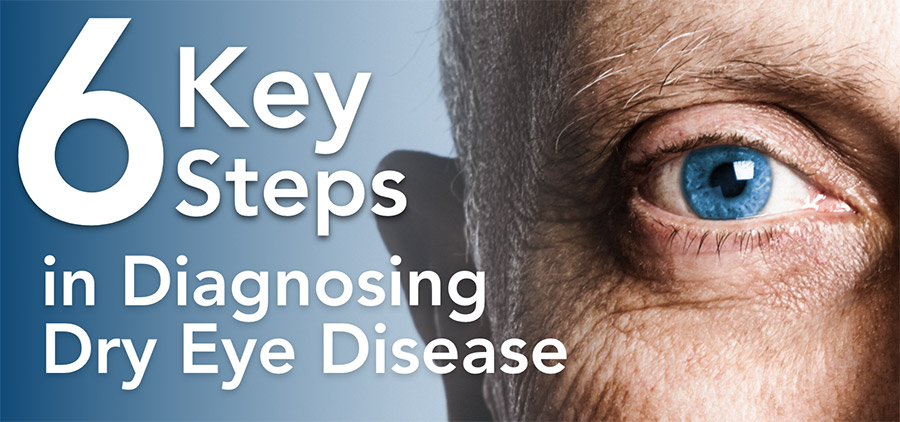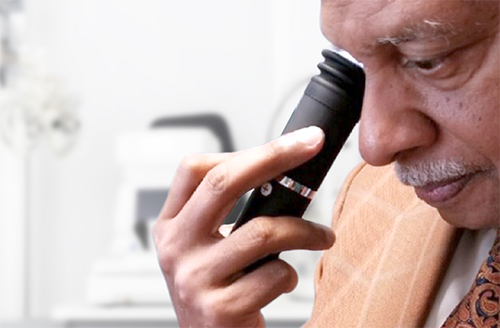Diagnosing Dry Eye Disease: Where to Start

Offering better quality eye care to your patients involves the introduction of a Dry Eye Disease focus to your practice. But where do you start before your first diagnosis? To begin diagnosing Dry Eye Disease, focus your efforts on reviewing 6 Key Steps to make sure you’ve covered your bases before you begin calling in patients.


Complete the Online Lessons for Diagnosing Dry Eye Disease
In the Diagnostics and Treatments Course, we guide you through an overview of diagnostics, including how to administer a tear osmolarity test, testing for allergies, Sjögren’s Syndrome, Rx testing, and emphasizing the importance of early Dry Eye diagnosis. Use of diagnostic systems is also discussed, including the 4-step process of InflammaDry testing for the inflammatory marker MMP-9 in ocular surface disease, the LipiView II to evaluate lipid layer thickness and eyelid blinking patterns, LipiScan for rapid Meibomian Gland Imaging, and the use of an HD Analyzer to measure optical scatter and tear film.


Determine the Type of Dry Eye Practice You’ll Become
Now that you understand the diagnostic tools you’ll need in diagnosing Dry Eye Disease, you need to determine which type of Dry Eye Practice you want to become. As you know, there are 3 types of a Dry Eye Practice, and each has a corresponding lesson within our Practice Implementation Course that discusses what their respective responsibilities are: 1) Referral Care, 2) Shared Care, and 3) Comprehensive Care. Review these lessons again to determine which is most appropriate for you and your practice.



Talk to Your Allies
Meet with your sales reps, vendors and manufacturers about any and all diagnostic tools you’re considering—they truly know the equipment and should be able to help guide you to which diagnostics will work best for your type of Dry Eye practice. Most manufacturers have purchase and leasing programs, and financial assistance through Fundation is offered for purchasing diagnostic and treatment systems.

Try Out Your Diagnostic Equipment
Before diagnosing Dry Eye Disease patients, start by empowering your staff with the knowledge of what each instrument does and why each is important. Have every member of your office trial the diagnostics themselves, including yourself and your providers. By having this firsthand information about how these tools work and how they benefit the patient, your staff will become comfortable with the procedures and the equipment that empowers it.


Get Out of the Gate with SPEED
Download the SPEED Questionnaire and print one out for every patient. By asking patients questions from the SPEED Questionnaire, you’ll quickly be on your way to quantifying the type and severity of their Dry Eye symptoms.


Create Your Own Standard of Care
Each practice is unique, but to help guide you early in the process, you can rely upon others’ experiences through their Standard of Care. Download the sample Standard of Care developed by Bowden Eye & Associates to help direct your patient assessment and diagnostics following the SPEED Questionnaire. This sample provides scenarios about what another practice does when successfully diagnosing Dry Eye Disease. This sample document will help provide guidance about which combination of Dry Eye diagnostic and treatment protocols may work for your practice.
Putting It All Together
So once you know how the diagnostics work, determining the type of Dry Eye practice you’ll become, what your sales reps recommend, how you and your staff feel about trialing the new diagnostics, and you’re familiar with the SPEED Questionnaire and sample Bowden Eye & Associates Standard of Care, you’ll be ready to start diagnosing Dry Eye Disease patients and getting them the help they need. Follow these simple steps and you’ll open up entirely new possibilities for your practice—and superior eye care for your Dry Eye patients.
Content referenced here is provided by the experts at Bowden Eye & Associates and is featured in their comprehensive Dry Eye University events.
Not a Member?
Join Dry Eye Access today!
Just one membership gives
Dry Eye Disease online learning, practice resources, and implementation tools to
your whole staff.


